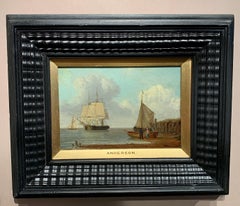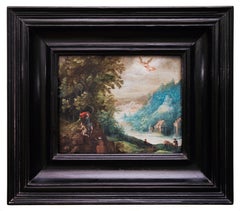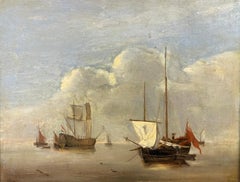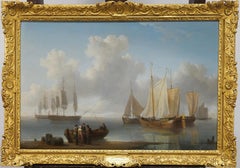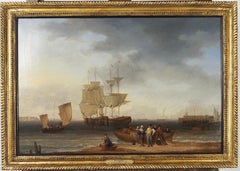William Anderson Paintings
British, 1757-1837
William (or Wiliam) Anderson (1757 – 27 May 1837) was a Scottish artist specializing in maritime and patriotic themes. He was well-regarded for his detailed and accurate portraits of ships under sail, exhibiting his works annually in London between 1787 and 1811 and then occasionally until 1834. Anderson influenced other artists, notably John Ward and others of the Hull school. Anderson's early life is obscure, but he is known to have trained as a shipwright before moving to London to become a maritime painter when he was about 30. His training served him well as a painter, providing "a practical nautical knowledge" of his subjects. He earned a reputation for "accuracy and refinement of detail" and was admired for his bright, clear colours. He worked in both oils and watercolours.
He based his style on that of well-known Dutch maritime painters of the 17th century. He first exhibited at the Royal Academy in 1787 and the Royal Institution in 1810, and continued to exhibit annually until 1811. He then exhibited intermittently until 1834.[6] His best work was executed in the years 1790–1810, during the French Revolutionary and Napoleonic Wars, at which time the demand for naval paintings was high. His painting was not restricted to marine subjects and included an exhibit in 1822 of a painting depicting the Battle of Waterloo. Like other artists of the time, Anderson's paintings of marine incidents were often based on sketches by participants and were bought by individuals who had risen in social standing and wealth during the wars.
Commissions that took Anderson back north introduced him to the Hull school of painters, notably influencing the young John Ward (1798–1849), who copied at least one of Anderson's paintings. He was also a friend and possibly a collaborator of the painter Julius Caesar Ibbetson (1759–1817). His work was influenced by his travels in the North, which led to depictions of Berwick-on-Tweed and Tynemouth. His last exhibit was of Lord Howe's fleet at Spithead at the Royal Academy in 1834, the last of 45 paintings that he exhibited there. He died in London on 27 May 1837.to
1
2
Overall Width
to
Overall Height
to
1
1
1
1
2
1
1
1
2
2
1
1
2
781
720
712
696
1
1
1
Artist: William Anderson
Antique English 19th century marine scene
By William Anderson
Located in Woodbury, CT
Outstanding English late 18th / early 19th century marine scene by one of Britain's best known and sought after painters.
William (or Wiliam) Anderson (1757 – 27 May 1837) was a Scottish artist specializing in maritime and patriotic themes. He was well-regarded for his detailed and accurate portraits of ships under sail, exhibiting his works annually in London between 1787 and 1811 and then occasionally until 1834. Anderson influenced other artists, notably John Ward and others of the Hull school.
Anderson's early life is obscure, but he is known to have trained as a shipwright before moving to London to become a maritime painter when he was about 30. His training served him well as a painter, providing "a practical nautical knowledge" of his subjects. He earned a reputation for "accuracy and refinement of detail" and was admired for his bright, clear colours. He worked in both oils and watercolours.
He based his style on that of well-known Dutch maritime...
Category
1810s Old Masters William Anderson Paintings
Materials
Oil, Wood Panel
$5,962 Sale Price
25% Off
Georgian Victorian Marine Oil Painting Shipping Scene possibly Isle of Wight
By William Anderson
Located in ludlow, GB
Georgian or early Victorian Marine Oil on Panel of busy shipping scene with figures on Harbour, possibly the Isle of Wight
A rare gem of a painting, a Georgian era oil painting sho...
Category
Late 18th Century William Anderson Paintings
Materials
Oil
Related Items
Abraham and the Sacrifice of His Son Isaac by Adriaen Van Stalbemt, C. 1605-1610
Located in Stockholm, SE
Artist: Adriaen van Stalbemt (Stalbempt) 1580-1662
Title: Abraham and the Sacrifice of His Son Isaac “Das Opfer des Abraham”
According to the Old...
Category
Early 1600s Old Masters William Anderson Paintings
Materials
Copper
Shipping in Calm Waters, 18th Century Dutch Oil on Wood Panel, Man o War
Located in Cirencester, Gloucestershire
Shipping in Calm Waters
Dutch School, 18th century
oil painting on wood panel
panel: 10 x 12.75 inches
framed: 14 x 17 inches
condition: very good, minor evidenc...
Category
18th Century Old Masters William Anderson Paintings
Materials
Oil, Wood Panel
$2,060 Sale Price
30% Off
H 14 in W 17 in D 1 in
17th century Flemish seascape - Stormy Sea with Merchant Vessels and dolphins
By Bonaventura Peeters the Elder
Located in Aartselaar, BE
Bonaventura Peeters the Elder (1614–1652) attr., Stormy Coastal Scene with Merchant Vessels, Galliot, and Dolphins
Framed by rugged cliffs and illuminated under a dark, swirling sk...
Category
17th Century Old Masters William Anderson Paintings
Materials
Panel, Oil
$7,670
H 16.15 in W 27.76 in
19th Century Roman Landscape oil on canvas with Giltwood Frame
Located in Rome, IT
Amaizing 19' century Roman landscape depicting a part of Villa Borghese with Trinità dei Monti.
With a finely carved gilt wood coeval frame.
Measurements with frame cm 65 x78 wit...
Category
19th Century Old Masters William Anderson Paintings
Materials
Oil
$5,310
H 25.6 in W 30.71 in D 1.97 in
Macbeth and the Three Witches a Painting on Panel by Francesco Zuccarelli
By Francesco Zuccarelli
Located in PARIS, FR
This painting, created during Zuccarelli's stay in England, represents the decisive moment when Macbeth, together with Banquo, meets the three witches who announce that he will be Ki...
Category
1760s Old Masters William Anderson Paintings
Materials
Oil, Wood Panel
$55,000
H 17.33 in W 22.05 in
Color Bloom, Bauhaus Vertical Painting in Purple & Turquoise Arches Grid, Paper
By Natalia Roman
Located in Barcelona, ES
This series of abstract geometric paintings by Natalia Roman draws its inspiration from the sleek grids and curves of Bauhaus architecture, while at the same time exploring bright an...
Category
2010s Analytic Cubist William Anderson Paintings
Materials
Paper, Oil, Acrylic
Wonderful Victorian oil of cows grazing in the Welsh or English hills
Located in Harkstead, GB
An idyllic view of cattle and sheep grazing in a pasture before an oak tree with a blue sky with bollowing clouds beyond.
William S Rose (1810-1873)
Cattle and sheep grazing in rou...
Category
Mid-19th Century Victorian William Anderson Paintings
Materials
Oil, Wood Panel
$1,342 Sale Price
20% Off
H 6.5 in W 9 in D 1.5 in
George Boyle Impressionist oil painting, Barbizon School of cows grazing
Located in Harkstead, GB
A superb example of a Barbizon inspired landscape painted by George Boyle, "the Catford Corot" from the late 19th Century. This very striking image shows the artist at the absolute ...
Category
Late 19th Century Impressionist William Anderson Paintings
Materials
Oil, Wood Panel
$2,483
H 10 in W 14 in D 2 in
John Berney Ladbrooke, 19th Century oil painting of a river landscape
By John Berney Ladbrooke
Located in Harkstead, GB
A most attractive painting with an extensive view towards a church tower, just as a rain shower is approaching. The picture includes a charming little figure group of a mother holdin...
Category
Mid-19th Century Victorian William Anderson Paintings
Materials
Panel, Oil
$1,677
H 14.5 in W 12 in D 2 in
Fine 17th Century Dutch Old Master Oil on Panel Angelic Visitation to Figures
By Rembrandt van Rijn
Located in Cirencester, Gloucestershire
The Angelic Visitation
Dutch School, mid 17th century
circle of Rembrandt (Dutch 1606-1669)
oil on wooden panel, framed in faux tortoiseshell style frame.
framed: 25 x 28.75
painting...
Category
17th Century Old Masters William Anderson Paintings
Materials
Oil, Wood Panel
$12,002 Sale Price
30% Off
H 25 in W 28.75 in D 1 in
The Road to Emmaus, German Old Master Painting
Located in Stockholm, SE
German School, 1700s
The Road to Emmaus
oil on panel
unframed: 24.3 x 17.5 cm (9.6 x 6.9 inches)
framed: 34.5 x 28 cm (13.6 x 11 inches)
Provenance:
Swedish author and artist Amel...
Category
18th Century Old Masters William Anderson Paintings
Materials
Wood Panel, Oil
Period Marine Landscape Credited to Warren Sheppard
By Warren W. Sheppard
Located in Roma, IT
This beautiful painting, due to its very high quality of execution, style and era, can be referred to the great artist Warren Sheppard, who specialized in seascapes.
Of great evocati...
Category
19th Century Old Masters William Anderson Paintings
Materials
Canvas, Oil
$3,304
H 15.75 in W 21.46 in D 2.76 in
Previously Available Items
Ships at low tide
By William Anderson
Located in Stoke, Hampshire
William Anderson (1757-1837)
Ships at low tide
Oil on panel
Signed and dated 1827 lower left
Painting Size 18 x 28 in
Framed Size 22 1/2 x 32 in
William Anderson (1757-1837) was a p...
Category
19th Century Victorian William Anderson Paintings
Materials
Oil
Figures unloading a boat at low tide, off Margate
By William Anderson
Located in Stoke, Hampshire
William Anderson (1757-1837)
Figures unloading a boat at low tide, off Margate
Oil on canvas
Signed and dated 1823 lower left
Painting Size 19 x 28 in
Framed Size 21 x 30 in
William Anderson (1757-1837) was a prominent English marine artist known for his detailed and historically significant depictions of naval battles and ships. His works offer a vivid glimpse into the maritime life of the 18th and early 19th centuries, capturing the essence of the British Navy's golden age.
Early Life and Background
William Anderson was born in 1757 in Scotland. Little is known about his early life and education, but his artistic talents became apparent at a young age. Anderson's interest in the sea and ships was likely influenced by his upbringing in a coastal region, which provided him with ample opportunities to observe maritime activities and develop a deep understanding of naval architecture and seafaring.
Artistic Career
Anderson moved to London to pursue his artistic career, where he found a vibrant art scene and a market eager for marine paintings. He quickly established himself as a skilled marine artist, admired for his accurate and detailed renderings of ships and naval engagements.
Style and Technique
Anderson's paintings are characterized by their meticulous attention to detail and historical accuracy. He had an exceptional ability to capture the intricate rigging, sails, and hulls of ships, as well as the dynamic nature of the sea. His use of color and light added depth and realism to his works, making them not only artistically appealing but also valuable records of maritime history.
Major Works and Achievements
Throughout his career, Anderson produced numerous paintings depicting famous naval battles, ship portraits, and coastal scenes. Some of his most notable works include:
The Battle of the Nile (1798) - This painting captures the dramatic naval engagement between the British Royal Navy, led by Admiral Horatio Nelson, and the French Navy. Anderson's portrayal of the chaotic battle scene showcases his skill in rendering complex action and movement.
HMS Victory - Anderson created several paintings of HMS Victory, the famous flagship of Admiral Nelson. His detailed depictions of the ship contribute significantly to our understanding of naval architecture during this period.
Merchant Vessels in Calm Seas - This work demonstrates Anderson's versatility as an artist, showcasing his ability to capture serene and peaceful maritime scenes with the same precision as his battle depictions.
Legacy
William Anderson's contributions to marine art have left an enduring legacy. His works are held in high regard by historians and art enthusiasts alike for their historical significance and artistic excellence. Many of his paintings are housed in prestigious collections, including the National Maritime Museum in Greenwich and various private collections.
Anderson's detailed representations of ships and naval engagements provide valuable insights into the maritime history of his time, making his works an important resource for researchers and historians. His ability to blend artistic skill with historical accuracy ensures that his legacy as one of the foremost marine artists of his era remains intact.
Personal Life and Death
Despite his professional success, details about Anderson's personal life remain sparse. He continued to paint and contribute to the marine art genre until his death in 1837. Anderson's life and work continue to be celebrated for their significant contributions to the artistic and historical documentation of naval history...
Category
19th Century Victorian William Anderson Paintings
Materials
Oil
Marine painting sea shore smugglers boat scotttish 19th
By William Anderson
Located in PARIS, FR
William ANDERSON (1757- 1837) Oil on wooden panel 25.5 x 34.5 cm (40x50cm with frame) Signed and dated lower left "W. Anderson / 1817" Collector's stamp on the back
Scottish painte...
Category
1810s Romantic William Anderson Paintings
Materials
Oil
Antique English 19th century marine scene
By William Anderson
Located in Woodbury, CT
Outstanding English late 18th / early 19th century marine scene by one of Britain's best known and sought after painters.
William (or Wiliam) Anderson (1757 – 27 May 1837) was a Scottish artist specializing in maritime and patriotic themes. He was well-regarded for his detailed and accurate portraits of ships under sail, exhibiting his works annually in London between 1787 and 1811 and then occasionally until 1834. Anderson influenced other artists, notably John Ward and others of the Hull school.
Anderson's early life is obscure, but he is known to have trained as a shipwright before moving to London to become a maritime painter when he was about 30. His training served him well as a painter, providing "a practical nautical knowledge" of his subjects. He earned a reputation for "accuracy and refinement of detail" and was admired for his bright, clear colours. He worked in both oils and watercolours.
He based his style on that of well-known Dutch maritime...
Category
1810s Old Masters William Anderson Paintings
Materials
Oil, Wood Panel
18th century Dutch warships at sea off with fishing boats in full sail
By William Anderson
Located in Woodbury, CT
William Anderson was born in Scotland in 1757, though the precise details of date and place are elusive. He trained initially as a shipwright, but by the age of thirty was an accompl...
Category
1780s Old Masters William Anderson Paintings
Materials
Oil
William Anderson paintings for sale on 1stDibs.
Find a wide variety of authentic William Anderson paintings available for sale on 1stDibs. You can also browse by medium to find art by William Anderson in oil paint, paint, panel and more. Much of the original work by this artist or collective was created during the 19th century and is mostly associated with the Old Masters style. Not every interior allows for large William Anderson paintings, so small editions measuring 10 inches across are available. Customers who are interested in this artist might also find the work of Sir Godfrey Kneller, Matthew Cook, and Giulio Di Sotto. William Anderson paintings prices can differ depending upon medium, time period and other attributes. On 1stDibs, the price for these items starts at $6,360 and tops out at $8,672, while the average work can sell for $6,360.
